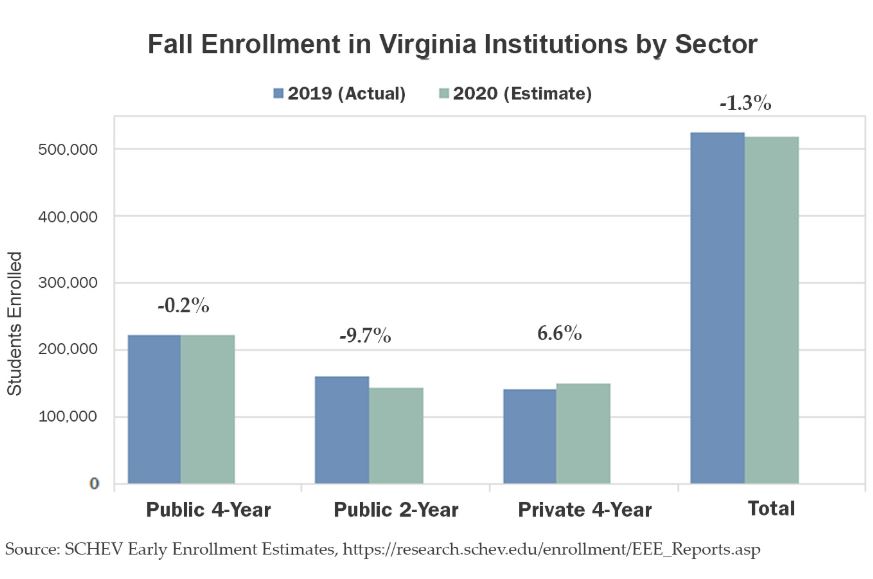Undergraduate enrollment in Virginia’s nonprofit higher-ed institutions has declined only 1.3% this fall, far less than feared in many quarters, according to preliminary estimates released today by the State Council of Higher Education for Virginia (SCHEV). There had been widespread concern that measures to combat the COVID-19 virus would disrupt campus life and discourage students from attending.
The decline was concentrated in Virginia’s community colleges, where enrollment was down 9.7%. That was a reversal of typical patterns during an economic downturn in which unemployed workers go back to community college to brush up on skills useful in the workplace. By contrast, enrollment surged 6.6% at private four-year institutions and remained stable (down only 0.2%) at public four-years.
Other tidbits from the SCHEV report:
- Enrollment by out-of-state students increased 3.2%, a trend most pronounced in the “private four-year college” category. One might conjecture that Virginia’s private colleges admitted more out-of-state students to offset an expected decline in in-state enrollment, which never materialized.
- Enrollment of graduate students was higher across the board, but the increase in out-of-state grad students (11.6%) was much higher than in-state grad students (1.8%). Again, the trend was particularly pronounced in the “private four-year college” category.
- Enrollment of students in the professions (law school, med school, the medical professions) also showed an in-state/out-of-state disparity. In-state enrollment was down 8.0% while out-of-state enrollment was up 7.2%. Once again, the “private four-year college” category outperformed the other groups.
Any definitive conclusions regarding trends among private colleges, however, must await an institution-by-institution look.
Meanwhile, looking ahead to when the official November enrollment numbers are reported, SCHEV says it will endeavor to ask a number of questions:
- What were the differences in enrollment between new students and continuing students?
- How does the above compare to prior years?
- What student populations were most affected? Demographic groups (race/ethnicity, gender), Pell recipients, first generation (this [is] only our second year collecting these data), first-year students from 2019, and other identifiable populations.
- Are students enrolling part-time in greater numbers? How might this affect academic progress?
- What are implications for institutional graduation rates and meeting the Commonwealth attainment goals in The Virginia Plan for Higher Education?
Other questions worth asking: To what degree did colleges and universities either (a) discount tuitions or (b) relax admissions standards, and how did those policies affect the in-state, out-of-state mix?
Fall 2020 undergraduate headcount at Virginia’s four-year public universities:
Christopher Newport: -1.6%
George Mason University: +2.1%
James Madison University: – 0.2%
Longwood University: -0.4%
Mary Washington University: -4.8%
Norfolk State University: -2.8%
Old Dominion University: +2.5%
Radford University: – 8.3%
University of Virginia: -0.8%
University of Virginia-Wise: -6.1%
Virginia Commonwealth University: -3.5%
Virginia Military Institute: No change
Virginia State University: -12.8%
Virginia Tech: +2.9%
William & Mary: -0.4%


Leave a Reply
You must be logged in to post a comment.